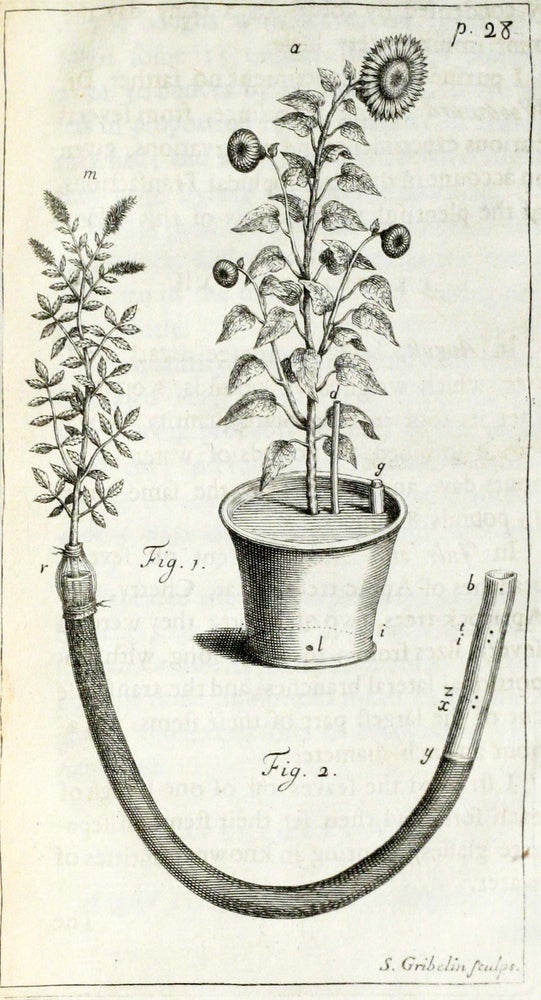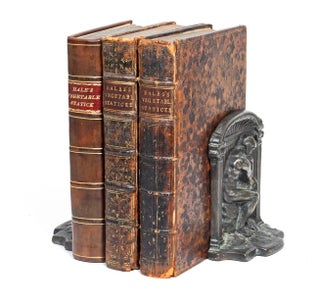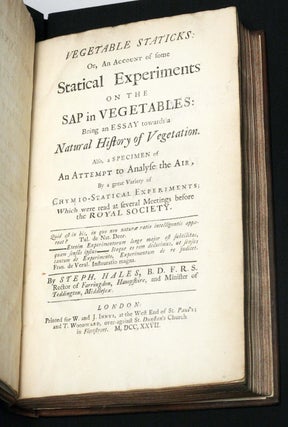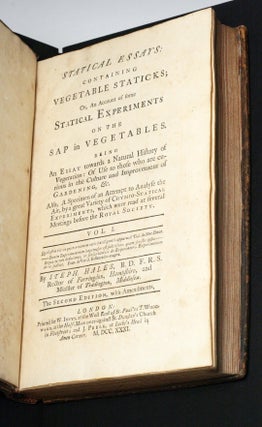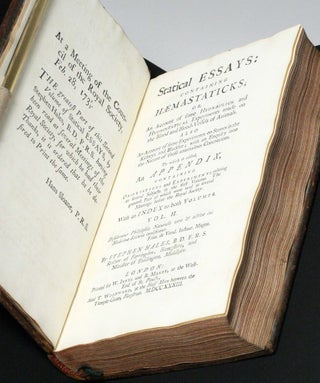Vegetable Staticks: Or, An Account of some Statical Experiments on the Sap in Vegetables (1727); I: Statical Essays: containing Vegetable Staticks and II: Statical Essays: containing Hæmastaticks (1731–33)
“Hales’s work marked the greatest advance in the physiology of circulation between Harvey and the introduction of the mercury manometer and other instruments for the measurement of blood pressure by J.L.M. Poiseuille in 1828.”
– John Carter and Percy H. Muir, PMM 189
FIRST EDITION AND FIRST COMPLETE TWO-VOLUME EDITION OF LANDMARK STUDIES ON CIRCULATION IN PLANTS AND HUMANS [PMM 189].
First published in 1727 as Vegetable Staticks, Stephen Hales’s seminal work on plant nutrition made groundbreaking advancements in understand sap movement and the discovery of root pressure—setting the stage for the achievements of Ingenhousz and de Saussure. This first edition of the first volume would receive a second volume in the 1730s focusing on human circulation and blood pressure, in which Hales shows both that “the capillary vessels are liable to constriction and dilation” and that “blood supply is largely determined by the state of contraction of the supply vessels, which are in their turn under nervous control” (PMM 189). This second volume was published alongside an updated, second edition of Vegetable Staticks from 1731 to 1733. Thus, the two-volume set constitutes the first complete edition of Hale’s Statical Essays.
The volumes present here are the three volumes mentioned above: the first edition of Vegetable Staticks (1727), and the two-volume, first complete edition titled Vegetable Staticks (1731–33) comprised of I: Vegetable Staticks and II: Hæmastaticks.
The papers were read across several meetings of the Royal Society in London, and it was the combined training in biological, mathematics and physics that earned Hale, a “modest country parson at Teddington”, a Fellowship of the Royal Society and its Copley Medal (PMM 189). A champion of public health, Hales is also credited with the invention of artificial circulation and developed means to increase ventilation of indoor spaces to prevent the spread of airborne diseases (PMM 189). Hales’s ventilator was fitted “in the House of Commons, the court of king’s bench, Drury Lane Theatre, and Newgate prison, and in hospitals, workhouses, and gaols throughout the country.” (DNB, para. 6 of 12).
The unique publication history of the present works witnesses two salient historical changes. The first volume as initially printed in 1727 (and reissued in 1731) is dedicated to George, Prince of Wales. With the Prince of Wales ascending the throne in June 1727, becoming George II, the two volumes straddle the coronation of a new sovereign. As such, the second volume of 1733 is addressed “To The King’s Most Excellent Majesty”. The Royal Society has been patroned by every sitting monarch since receiving its Royal Charter from Charles II in 1662. That all three texts are dedicated to the same individual, however, raises the question of why the Prince of Wales is named in the first volume, and not George I. As the first Hanoverian ruler of Great Britain, George I failed to win the affection of the public in England, and his exclusion from the first volume possibly reflects this popular disinterest. He was widely reported to have not spoken English and his funeral was held in Germany after he had died on a visit to his homeland of Hanover. The ceremony was not attended by his son, George II, and this was interpreted by many in England as a mark in favour of the new king (Van der Kiste, p. 97). By honouring George II even as heir apparent in 1727, Hales’ volumes likely participate in this wider historical and cultural moment.
The additional transition marked by the present volumes concerns the presidency of the Royal Society. Newton held the office until his death on 31 March, 1727. As such, the two copies of the first volumes both bear the mark: “Feb. 16, 1726-7. Imprimatur Isaac Newton. Pr. Reg. Soc.” In contrast, the second volume is endorsed by Newton’s predecessor Hans Sloane—making Vegetable Staticks one of the final contributions to knowledge released by the Society in Newton’s lifetime and under his direction.
HALES, STEPHEN. Vegetable Staticks: Or, An Account of some Statical Experiments on the Sap in Vegetables: Being an Essay towards a Natural History of Vegetation. Also, a Specimen of An Attempt to Analyse the Air, By a Great Variety of Chymio-Statical Experiments. London: W. and J. Innys and T. Woodward, 1727. First edition. Octavo, [vi] (blank leaves added in rebinding), [ix] (title and dedication), vii (preface), [ii] (contents), 376, [6] (blank leaves added in rebinding), handsome recent sympathetic paneled calf. Some library stamps (see Provenance below), otherwise fine condition.
Provenance: Faint stamp on title and scattered stamps in text from "Mercantile Library, Philadelphia". The Mercantile Library was an important early American library for merchants. Founded in 1821, it closed in 1989.
AND
HALES, STEPHEN. Statical Essays. 2 vols.
(a) Statical Essays: containing Vegetable Staticks; Or, An Account of some Statical Experiments on the Sap in Vegetables. Being An Essay towards a Natural History of Vegetation: Of Use to those who are curious in the Culture and Improvement of Gardening, &c. Also, A Specimen of an Attempt to Analyse the Air, by a great Variety of Chymio-Statical Experiments. Second edition, “with Amendments”. Octavo, [iv] (blank), [vi] (title and dedication), viii (preface), [iv] (contents), 376, [4] (blank) pp., 19 engraved plates by S. Gribelin. Contemporary speckled calf, new label /condition report/; marbled endpapers with bookplate of physician Kenneth Shallcross Dickinson. London: W. Innys, T. Woodward and J. Peele, 1731.
(b) Statical Essays: containing Hæmastatics; Or, An Account of some Hydraulick and Hydrostatical Experiments made on the Blood and Blood-Vessels of Animals. Also An Account of some Experiments on Stones in the Kidneys and Bladder; with an Enquiry into the Nature of those anomalous Concretions. To which is added, An Appendix, containing Observations and Experiments relating to several Subjects in the first Volume. London: W. Innys, R. Manby and T. Woodward, 1733. Octavo, [iv] (blank), xxii (title, dedication and preface), xxvi (contents and introduction), 361, [1] (errata), [22] (index), [4] (blank) pp. Matching contemporary speckled calf, later spine labels; marbled endpapers. Handsome bookplate of physician Kenneth Shallcross on front pastedown of each volume. Light wear to handsome contemporary bindings with some chipping at spine ends. Vol 1 with a little scattered foxing; Vol 2 text exceptionally clean.
References:
DNB: D.G.C. Allen, “Hales, Stephen (1677–1761)”, Dictionary of National Biography (Oxford: Oxford University Press, 2004)
PMM: Carter, John and Percy H. Muir, “189. Plant Nutrition”, Printing and the Mind of Man (London: Cassell, 1967), p. 112
Van der Kiste, John, George II and Queen Caroline (Stroud: Sutton, 1997).
Price: $5,500 .


